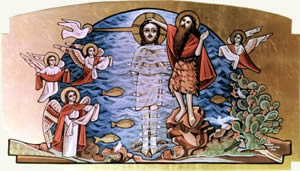- Arabic Corner
- Audio
- Bible Study
- Coptic Reader
- Children's Corner
- Deacons
- Evangelism & Apologetics
- Evangelism Pamphlets
- Interesting Facts
- Literature
- Pigori Productions
- Priests Corner
- Questions & Answers
- Reading Recommended
- Saintly Studies
- Servants Guide
- Sunday School Curriculum
- Sunday School Curriculum-Special Needs
- Youth Corner
Interesting Holy Bible Facts
One Feast: The Feast of the Nativity and the Feast of the Epiphany
by Fr. Shenouda Maher Ishak
 Both the Nativity and the Baptism of our Lord Jesus Christ are celebrated as Feasts of the Theophany, or Divine Manifestation.
Both the Nativity and the Baptism of our Lord Jesus Christ are celebrated as Feasts of the Theophany, or Divine Manifestation.
Through His glorious birth, He is manifested as God Incarnate, the Son of Man. "And the Word became flesh and dwelt among us, and we beheld His glory, the glory as of the Only-begotten of the Father, full of grace and truth" (John 1:14). "But when the fullness of the time had come, God sent forth His Son, born of a woman, born under the law, to redeem those who were under the law, that we might receive the adoption as sons" (Galatians 4:4-5). After His Baptism, He was revealed as the Second Person, or Hypostasis, of the Holy Trinity, and thus the Son of God. "And suddenly a voice came from heaven, saying, 'This is My beloved Son, in whom I am well please'" (Matthew 3:17; compare Mark 1:11, Luke 3:22).
In fact, in the early Church the Feast of the Nativity and the Feast of Epiphany were celebrated as one feast on January 6 (Julian calendar = Coptic month Tobe 11), called the Feast of Epiphany. In the East, the introduction of a separate feast for the Nativity on December 25 (Julian calendar = Coptic month Kioahk 29) occurred in the later 4 th century. The writings of St. John Chrysostom enable us to fix 378 A.D. as the date at which the observance of the Feast of the Nativity on December 25 was introduced at Antioch. In a sermon preached there in 388 on the Feast of the Nativity he states that its observance was not yet quite ten years old (Encyclopedia of Religion and Ethics, vol. 3, p. 603)
In Alexandria, it must have been introduced between 400 and 432 A.D., and probably on or closer to 432, since from the Paschal letter of St. Theophilus of Alexandria in 400 A.D., it is clear that the Nativity and the Baptism were both celebrated on January 6. Paul of Emesa had been sent by John of Antioch to make peace with St. Cyril of Alexandria, and he preached two sermons in Alexandria on the Incarnation. The first was preached on the Feast of the Nativity on Kioahk 29 (December 25) and the second on Tuba 6 (January 1) in 432. Thus in 432, the Feast of the Nativity had been already separated from that of the Baptism (Ibid., p. 604).
This separation occurred even later in Jerusalem (Ibid.).
But the Armenians did not accept the separation of the two feasts except for a short period, and in the sixth century they resumed their ancient use (Ibid., p. 605) which they observe until the present day. Now they celebrate both feasts on January 6 according to the modern Gregorian calendar and not the Julian calendar.
Thus, in our Coptic Orthodox Church, the tradition is to celebrate the Feast of the Nativity up until the Feast of the Epiphany as had been preserved in Upper Egypt throughout the centuries.
Taken from the book, "Liturgical and Ritual Issues and Proposals Concerning the Restoration of Communion" by Fr. Shenouda Maher.